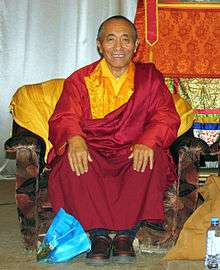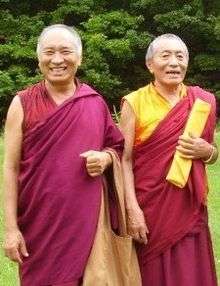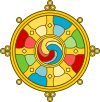Palden Sherab
Khenchen Palden Sherab Rinpoche (Tibetan: དཔལ་ལྡན་ཤེས་རབ་, Wylie: dpal ldan shes rab ) (May 10, 1938 – June 19, 2010), called Khen Rinpoche, is a teacher, a scholar, a lama, and a Dzogchen master in the Nyingma school of Tibetan Buddhism. He was considered by Penor Rinpoche to be one of the most learned Nyingma scholars alive.[1]


| Part of a series on |
| Buddhism |
|---|
 |
|
|
|
| Part of a series on |
| Tibetan Buddhism |
|---|
 |
|
|
|
Practices and attainment |
|
Institutional roles |
|
History and overview |
Born in Tibet, Khen Rinpoche escaped the Chinese in 1960 to arrive in India where he joined other monastic leaders to collect and salvage Tibetan buddhist teachings carried by the exile community. He became the Nyingma professor at the Central University of Tibetan Studies, in 1967. As a close student of Dudjom Rinpoche, Khen Rinpoche also taught in France and in the United States. Khen Rinpoche founded Padmasambava Buddhist Center in upstate New York, U.S., which grew to include centers in Mexico, Canada, Puerto Rico, India and Russia. Khenchen Palden Sherab Rinpoche's seat is Orgyen Samye Chokhor Ling Nunnery in India. The Yangsi Rinpoche was born in Nepal, and enthroned in India as Palden Yonten Thaye Lodro Choyki Gyaltsen.
Life
Khenchen Palden Sherab Rinpoche was born in the village of Joephu (Tibetan: རྒྱུས་ཕུ་, Wylie: rgyus phu ), in the Dhoshul (Tibetan: རྡོ་ཤུལ་, Wylie: rdo shul ) region of Kham, Tibet, near the sacred mountain of Jowo Zegyal (Tibetan: ཇོ་བོ་གཟེ་རྒྱལ་, Wylie: jo bo gze rgyal ). He entered monastic studies at the age of 6 years at Gochen Monastery, founded by Tsasum Lingpa. His nickname was "the Cyclone" due to his constant activities.[2] At the age of 12, Khen Rinpoche entered Riwoche Monastery in eastern Tibet. Just prior to China's invasion, he completed his shedra (monastic university) education at the Taklung Kagyu monastery of Riwoche (Tibetan: རི་བོ་ཆེ་, Wylie: ri bo che ), in the Riwoche region of Kham, where he was being groomed to take over as the khenpo, or abbot, of Gochen Monastery (Tibetan: སྒོ་ཆེན་སྒོམ་, Wylie: sgo chen sgom ) which his family had administered for generations.
Following China's annexation of eastern Tibet, he fled with his family over the Himalayan mountains into India in the winter of 1960. They escaped from capture on three occasions. His sister Ting Ting and another sister died during the journey, as did his mother shortly after arriving in India. Khen Rinpoche's father, Lama Chimed Namgyal Rinpoche, and his brother, Khenpo Tsewang Dongyal Rinpoche, survived. After the escape, they lived in Indian refugee camps with others fleeing the Chinese.
Khenchen Palden Sherab Rinpoche received full ordination three years after escaping. While in exile, Dudjom Rinpoche requested that Khen Rinpoche join a year-long conference, overseen by the 14th Dalai Lama, of the four main Tibetan buddhist schools dedicated to protecting the culture and spiritual heritage of Tibet. Their focus was also recovering sacred texts missing or destroyed in the struggle with China. Khen Rinpoche salvaged thousands of texts and commentaries, and the complete cycle of teachings was recovered.
In 1967, the Central University for Tibetan Studies, which resulted from the conference, opened in Sarnath. Khen Rinpoche was for a time the only professor and administrator of the Nyingma Department, teaching up to 13 classes a day in the first years. He taught there for 17 years, writing the text from Mipham Rinpoche on a blackboard. He also taught in the Tibetan department at the Government Sanskrit College in Varanasi. In 1984, he drafted the basis for the commentary, "The Radiant Light of the Sun and Moon", published by the Central University in 1986.
Khenchen Palden Sherab Rinpoche first traveled to the U.S. in 1980 with his brother, Khenpo Tsewang Dongyal Rinpoche. In 1981, Khen Rinpoche replaced his brother as Khenpo of Dudjom Rinpoche's Dorje Nyingpo center in Paris, France, due to Khenpo Tsewang's problems with travel documents. In 1984, they followed and attended Dudjom Rinpoche in New York and then California, and taught periodically at Yeshe Nyingpo. In 1985, Khen Rinpoche founded Dharma Samudra, a non-profit publishing organization, and with his brother published 11 volumes on Tsasum Lingpa as the inaugural publication. They were referred to as "The Khenpo Brothers" by western practitioners. Khen Rinpoche wrote and published numerous texts on Tibetan history, language, poetry, grammar, Buddhist philosophy, practice, logic, as well as text and commentary on tantra.
In 1989, Padmasambhava Buddhist Center was founded, and its main retreat center and monastery is Palden Pema Samye Ling, (Tibetan: དཔལ་ལྡན་པདྨ་བསམ་ཡས་གླིང་, Wylie: dpal ldan pad+ma bsam yas gling ) located in Sidney Center, Delaware County, New York. PBC grew to include retreat centers and monastic institutions in the U.S., Canada, Puerto Rico, Russia, and India. Khen Rinpoche undertook large building projects at the monasteries and centers, and completed the Miracle Stupa at Padma Samye Jetavan in Shravasti. In Tibet, he also began rebuilding Gochen Monastery.
Khenchen Palden Sherab Rinpoche passed into paranirvana on Saturday, June 19, 2010 at Palden Pema Samye Ling. His body (Tibetan: སྐུ་གདུང་, Wylie: sku gdung ) remained there in post-death meditation (Tibetan: ཐུགས་དམ་, Wylie: thugs dam ) until Wednesday, June 23, 2010. He was cremated on Thursday, June 24, 2010. In this life, he received recognition, honors, and appointments from Dudjom Rinpoche, the 14th Dalai Lama, head of the Nyingma school Penor Rinpoche, and other Tibetan spiritual leaders. Penor Rinpoche stated Khenchen Palden Sherab Rinpoche was the most learned Nyingma scholar presently alive.
The Yangsi Rinpoche of Khenchen was located in Nepal, where he was born. In 2019, he was enthroned in India by Terton Namkha Drimed Rinpoche, and given the name Palden Yonten Thaye Lodro Chokyi Gyaltsen. His seat is the Orgyen Samye Chokhor Ling Nunnery in India.
Khenchen Palden Sherab Rinpoche held full knowledge in the Theravada, Mahayana, and Vajrayana schools, and held transmissions in Nyingma ka-ma and terma lineages. He was particularly well known and respected for his texts and teachings on Dzogchen (Tibetan: རྫོགས་ཆེན་, Wylie: rdzogs chen ).
Publications
English
- Khenchen Palden Sherab. Radiant Light of the Sun and Moon. Central University for Tibetan Studies, 1986.
- Khenchen Palden Sherab. Prajnaparamita: The Six Perfections. Sky Dancer Press, 1990. ISBN 1-880975-00-9
- Khenchen Palden Sherab. The Commentary on Mipham's Sherab Raltri Entitled: The Blazing Lights of the Sun and Moon. Dharma Samudra, 1997.
- Khenchen Palden Sherab. The Smile of Sun and Moon: A Commentary on the Praise to the Twenty-One Taras, Translated by Anna Orlova. Sky Dancer Press, 2004. ISBN 1-880975-07-6
- Khenchen Palden Sherab and Khenpo Tsewang Dongyal. Door to Inconceivable Wisdom and Compassion. Sky Dancer, 1996.
- Khenchen Palden Sherab and Khenpo Tsewang Dongyal. Lion's Gaze: A Commentary on Tsig Sum Nedek. Sky Dancer Press, 1998. ISBN 1-880975-05-X
- Khenchen Palden Sherab and Khenpo Tsewang Dongyal. Ceaseless Echoes of Great Silence. Sky Dancer Press, 1999. ISBN 1-880975-02-5
- Khenchen Palden Sherab and Khenpo Tsewang Dongyal. Opening To Our Primordial Nature. Snow Lion Publications, 2006. ISBN 1-55939-249-5
- Khenchen Palden Sherab and Khenpo Tsewang Dongyal. Tara's Enlightened Activity: An Oral Commentary on The Twenty-one Praises to Tara. Snow Lion Publications, 2007. ISBN 1-55939-287-8
- Khenchen Palden Sherab and Khenpo Tsewang Dongyal. Illuminating the Path: Ngondro Instructions According to the Nyingma School of Vajrayana Buddhism. Padmasambhava Buddhist Center, 2008.
- Khenchen Palden Sherab and Khenpo Tsewang Dongyal. The Dark Red Amulet: Oral Instructions of the Practice of Vajrakilaya. Snow Lion Publications, 2008. ISBN 1-55939-311-4
- Khenchen Palden Sherab and Khenpo Tsewang Dongyal. Beauty of Awakened Mind: Dzogchen Lineage of Shigpo Dudtsi. Dharma Samudra, 2013.
PSL Shedra Texts
- Khenchen Palden Sherab and Khenpo Tsewang Dongyal. Opening the Clear Vision of the Vaibhashika and Sautrantika Schools. PSL Shedra Series, Volume 1, Dharma Samudra, 2007.
- Khenchen Palden Sherab and Khenpo Tsewang Dongyal. Opening the Clear Vision of the Mind Only School. PSL Shedra Series, Volume 2, Dharma Samudra, 2007.
- Khenchen Palden Sherab and Khenpo Tsewang Dongyal. Opening the Wisdom Door of the Madhyamaka School. PSL Shedra Series, Volume 3, Dharma Samudra, 2008.
- Khenchen Palden Sherab and Khenpo Tsewang Dongyal. Opening the Wisdom Door of the Rangtong and Shentong Views: A Brief Explanation of the One Taste of the Second and Third Turnings of the Wheel of Dharma. PSL Shedra Series, Volume 4, Dharma Samudra, 2009.
- Khenchen Palden Sherab and Khenpo Tsewang Dongyal. Opening the Wisdom Door of the Outer Tantras: Refining Awareness Through Ascetic Ritual and Purification Practice. PSL Shedra Series, Volume 5, Dharma Samudra, 2009.
- Khenchen Palden Sherab and Khenpo Tsewang Dongyal. Splendid Presence of the Great Guhyagarbha: Opening the Wisdom Door of the King of All Tantras. PSL Shedra Series, Volume 6, Dharma Samudra, 2011.
- Khenchen Palden Sherab and Khenpo Tsewang Dongyal. Key to Opening the Wisdom Door of Anuyoga. PSL Shedra Series, Volume 7, Dharma Samudra, 2015.
- Khenchen Palden Sherab. Turning the Wisdom Wheel of the Nine Golden Chariots. PSL Shedra Series, Volume 8, Dharma Samudra, 2011. (From a 1987 teaching in Australia)
English and Tibetan
Spanish
- Khenchen Palden Sherab y Khenpo Tsewang Dongyal. La Luz del Dharma. Dharma Samudra, 2011.
- Khenchen Palden Sherab. Echos Incesantes del Gran Silencio: Un Comentario sobre la Prajñāpāramitā del Sūtra del Corazón. (Texto tibetano y traducción. Traducción del tibetano por Khenpo Tsewang Dongyal. Traducción al castellano, notas y glosario de Ferrán Maestanza i García. Ed Kairós.) Dharma Samudra, 2019. ISBN 978-84-7245-522-1
Tibetan
- The Blazing Lights of the Sun and Moon (Tibetan: དོན་རྣམ་རྣམ་པར་ངེས་པ་ཤེས་རབ་རལ་གྲིའི་འགྲེལ་པ་ཤེས་རབ་ཉི་ཟླ་འབར་བའི་སྒྲོན་མེ།, Wylie: don rnam par nges pa shes rab ral gri'i 'grel pa shes rab nyi zla 'bar ba'i sgron me/ )
- Pleasure Lake of Nagarjuna's Intention (Tibetan: དབུ་མ་སྤྱིའི་དོན་རྣམ་པར་གཞག་པ་ཀླུ་སྒྲུབ་དགོངས་པའི་རོལ་མཚོ།, Wylie: dbu ma spyi'i don rnam par gzhag pa klu sgrub dgongs pa'i rol mtsho/ )
- Supreme Clear Mirror (Tibetan: ཚད་མའི་མདོ་ཀུན་ལས་བཏུས་པའི་མཆོད་བརྗོད་ཀྱི་རྣམ་འགྲེལ་ལེའུ་གཉིས་པའི་བསྟན་པ་དང་སྟོན་པ་ཚད་མར་གྲུབ་པའི་དངོས་སྟོབས་རིགས་པའི་དགུ་ཚིགས་སྐྱ་མོ།, Wylie: tshad ma'i mdo kun las btus pa'i mchod brjod kyi rnam 'grel le'u gnis pa'i bstan pa dang ston pa tshad mar grub pa'i dngos stobs rigs pa'i dgu tshigs skya mo/ )
- The Ornament of Stars at Dawn (Tibetan: ཉི་ཤུ་པའི་མཆན་འགྲེལ་གྱི་ས་བཅད་ཐོ་རངས་སྐར་རྒྱན།, Wylie: nyi shu pa'i mchan 'grel gyi sa bcad tho rangs skar rgyan/ )
- The Mirror of Mindfulness (Tibetan: རྒྱལ་དབང་སངས་རྒྱས་པདམའི་གདམས་ངག་བར་དོའི་རྣམ་བཤད་དྲན་པའི་མེ་ལོང།, Wylie: rgyal dbang sangs rgyas padma'i gdams ngag bar do'i rnam bshad dran pa'i me long/ )
- Naturally Blazing Great Bliss (Tibetan: གཏུམ་མོའི་རྣམ་བཤད་བདེ་ཆེན་རང་འབར།, Wylie: gtum mo'i rnam bshad bde chen rang 'bar/ )
- Clouds of Blessings (Tibetan: རྩ་གསུམ་གླིང་པའི་གསོལ་འདེབས་ཀྱི་འགྲེལ་ཆུང་བྱིན་བརླབས་སྤྲིན་ཕུང།, Wylie: rtsa gsum gling pa'i gsol 'debs kyi 'grel chung byin brlabs sprin phung/ )
- White Lotus (Tibetan: གུ་རུའི་གསོལ་འདེབས་བསམ་པ་ལྷུན་གྲུབ་དང་བར་ཆད་ལམ་སེལ་བསྡུས་པའི་ཚིག་གི་འགྲེལ་པ་པདམ་དཀར་པོ།, Wylie: gu ru'i gsol 'debs bsam pa lhun grub dang bar chad lam sel bsdus pa'i tshig gi 'grel pa padma dkar po/ )
- The Essence of Diamond Clear Light (Tibetan: རྫོགས་པ་ཆེན་པོ་ཀུན་བཟང་དགོངས་པ་ཟང་ཐལ་རྒྱུད་ལས་སྨོན་ལམ་སྟོབས་པོ་ཆེའི་བསྡུས་དོན་འོད་གསལ་རྡོ་རྗེ་སྙིང་པོ་ཉི་མའི་གཟི་འོད།, Wylie: rdzogs pa chen po kun bzang dgongs pa zang thal rgyud las smon lam stobs po che'i bsdus don 'od gsal rdo rje snying po nyi ma'i gzi 'od/ )
- Taking Kindness as Path (Tibetan: རྒྱལ་བ་བྱམས་པའི་སྨོན་ལམ་བྱམས་པ་ལམ་ཁྱེར།, Wylie: rgyal ba byams pa'i smon lam byams pa lam khyer/ )
- Opening the Eyes of Wisdom (Tibetan: གནུབས་ཆེན་སངས་རྒྱས་ཡེ་ཤེས་ཀྱི་བསམ་གཏན་མིག་སྒྲོན་ལེའུ་རྣམས་ཀྱི་སྤྱི་བཤད་མདོར་བསྡུས་ཤེས་རབ་མིག་འབྱེད།, Wylie: gnubs chen sangs rgyas ye shes kyi bsam gtan mig sgron le'u rnams kyi spyi bshad mdor bsdus shes rab mig 'byed/ ) a commentary on the Samten Migdron
- Blazing Clouds of Wisdom and Compassion (Tibetan: གསང་སྔགས་ཡིག་བརྒྱ་པའི་རྡོ་རྗེའི་ཚིག་འགྲེལ་ཤེས་རབ་སྙིང་རྗེའི་འབར་བའི་སྤྲིན་ཕུང།, Wylie: gsang sngags yig brgya pa'i rdo rje'i tshig 'grel shes rab snying rje'i 'bar ba'i sprin phung/ )
- Advice from Kamalashila (Tibetan: རྡོ་རྗེ་གཅོད་པའི་བསྡུས་དོན་འགྲེལ་པ་ཀ་མ་ལ་ཤི་ལའི་ཞལ་ལུང།, Wylie: rdo rje gcod pa'i bsdus don 'grel pa ka ma la shi la'i zhal lung/ )
- The Diamond Sutra, with an outline based on the above commentary (Tibetan: འཕགས་པ་ཤེས་རབ་ཀྱི་ཕ་རོལ་ཏུ་ཕྱིན་པ་རྡོ་རྗེ་གཅོད་པའི་ས་བཅད་བསྡུས་་པ།, Wylie: 'phags pa shes rab kyi pha rol tu phyin pa rdo rje gcod pa'i sa bcad bsdus pa/ )
- Advice from the Ancestral Vidyadhara (Tibetan: ལམ་རིམ་རིན་ཆེན་སྤུངས་པའི་བསྡུས་དོན་སྔ་འགྱུར་རིག་འཛིན་མྱེས་པོའི་ཞལ་ལུང།, Wylie: lam rim rin chen spungs pa'i bsdus don snga 'gyur rig 'dzin myes po'i zhal lung/ )
- Smiling Red Lotus (Tibetan: མཁའ་འགྲོའི་གཙོ་མོ་ཡེ་ཤེས་མཚོ་རྒྱལ་གསོལ་འདེབས་འགྲེལ་ཆུང་པདམ་དམར་པོ་བཞད་པ།, Wylie: mkha' 'gro'i gtso mo ye shes mtsho rgyal gsol 'debs 'grel chung padma dmar po bzhad pa/ )
- Lotus Necklace of Devotion (Tibetan: མཁན་ཆེན་བསྟན་འཛིན་གྲགས་པའི་རྣམ་ཐར་དད་ལྡན་པདམའི་དོ་ཤལ།, Wylie: mkhan chen bstan 'dzin grags pa'i rnam thar dad ldan padma'i do shal/ )
- Waves of the Ocean of Devotion (Tibetan: གནུབས་ཆེན་སངས་རྒྱས་ཡེ་ཤེས་ཀྱི་རྣམ་པར་ཐར་པ་ལ་བསྟོད་པ་དད་པ་རྒྱ་མཚོའི་རྦ་རླབས།, Wylie: gnubs chen sangs rgyas ye shes kyi rnam par thar pa la bstod pa dad pa rgya mtsho'i rba rlabs/ )
- Vajra Rosary (Tibetan: གནུབས་ཆེན་སངས་རྒྱས་ཡེ་ཤེས་ཀྱི་སྐྱེས་རབས་རིག་འཛིན་རྣམས་ཀྱི་གསོལ་འདེབས་རྣམ་ཐར་མདོར་བསྡུས་བཀོད་པ་རྡོ་རྗེའི་ཕྲེང་བ།, Wylie: gnubs chen sangs rgyas ye shes kyi skyes rabs rig 'dzin rnams kyi gsol 'debs rnam thar mdor bsdus bkod pa rdo rje'i phreng ba/ )
- Opening the Door of Blessings (Tibetan: མ་གཅིག་ལབས་སྒྲོན་གྱི་རྣམ་ཐར་བསྡུས་པ་བྱིན་རླབས་སྒོ་འབྱེད།, Wylie: ma gcig labs sgron gyi rnam thar bsdus pa byin rlabs sgo 'byed/ )
- Cycle of Poems (Tibetan: ཚིགས་བཅད་སྐོར།, Wylie: tshigs bcad skor/ )
- Cycle of Prayers (Tibetan: གསོལ་འདེབས་སྐོར།, Wylie: gsol 'debs skor/ )
- Verses of Auspiciousness (Tibetan: ཤིས་སྨོན་སྐོར།, Wylie: shis smon skor/ )
- Cycle of Sadhanas (Tibetan: སྒྲུབ་ཐབས་སྐོར།, Wylie: sgrub thabs skor/ )
Works by others about Khenchen Palden Sherab Rinpoche
- Three Praises To Khenchen Palden Sherab Entitled Melodious Sound of the Ocean of Devotion by Khenpo Pema Gyaltsen (Tibetan: རྗེ་བཙུན་བླ་མའི་བསྟོད་པ་མོས་གུས་རྒྱ་མཚོའི་དབྱངས་ཚིག།, Wylie: rje btsun bla ma'i bstod pa mos gus rgya mtsho'i dbyangs tshig/ )
See also
- Dudjom Rinpoche
- Gochen
- Khenpo Tsewang Dongyal Rinpoche
- Kunu Lama
- Lama Chimed Namgyal Rinpoche
- Padmasambhava Buddhist Center
References
- Dharma Fellowship, Khenchen Palden Sherab, Contemporary Master Biographies, http://www.dharmafellowship.org/biographies/contemporarymasters/khenchen-palden-sherab.htm
- Turtle Hill Sangha web site, http://www.turtlehill.org/cleanup/khen/zkpsr.html
External links
- Padmasambhava Buddhist Center
- Brilliant Lotus Garland of Glorious Wisdom: A Glimpse Into the Ancient Lineage of Khenchen Palden Sherab Rinpoche
- Biographies: The Venerable Khenchen Palden Sherab Rinpoche
- Collected Works of Khenchen Palden Sherab Rinpoche
- Snow Lion Publications: Khenchen Palden Sherab Rinpoche
- "A Dzogchen Approach to Meditation" by Khenpo Palden Sherab Rinpoche
- Turtle Hill Sangha: Palden Tsawa'i Lama Rinpoche
- Tibetan Buddhist Resource Center Blog: Remembering Khenchen Palden Sherab Rinpoche
- Tibetan Buddhist Resource Center: Palden Sherab
- Pe-mai Chiso: Books by the Venerable Khenpo Rinpoches
- Pe-mai Chiso: Morning Dawn Study Series by the Venerable Khenpo Rinpoches